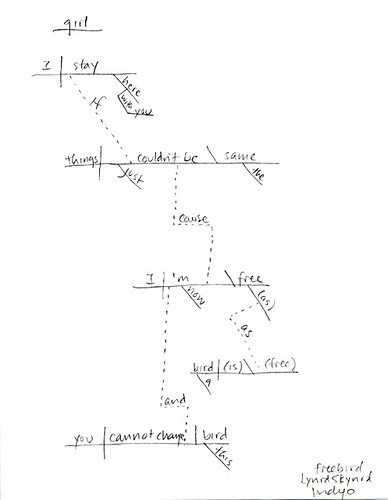Coming to Shadowshop soon (early next week, I guesstimate): grammatical sentence diagrams of pop lyrics!

Long-time readers of this blog may recall me as Dr. Diagram, diagramming lyrics to order at the Art Health Fair at the Oakland Museum in 2003, or Roadside Elixir at the Headlands in 2004. Well, if you missed those opportunities, you can still truck on down to SFMOMA & get yer rock & roll mitts on a hand-drawn diagram—for just $12! Choose from classics like “Freebird” by Lynyrd Skynyrd (pictured above), “Last Dance” by Donna Summer or “Stairway to Heaven” by Led Zeppelin!
I couldn’t resist sneaking a Dead tune in there too…

Following is the little blurb that’s tucked in with each diagram, except here, you get links with that:
Mere days into 6th grade, I found myself sitting on the gym floor in a circle of girls, who began passing around a David Cassidy LP so that each of us could kiss his picture on the cover. I was the new girl in this school; no way could I afford not to kiss it with as much enthusiasm as I could fake (not much at all—I was soon relegated to the nerd clique, if you could call it that). So began my adolescent crash-course in pop music, which gave me my generational & cultural identity (just as it has done & continues to do for decades of 6th-grade girls). Around the same time I also learned how to diagram sentences; this methodical, visual organization of language so elegantly revealed grammar’s structure that I loved it even then. (How’s that for nerd cred?!)
As an artist, I’m always looking at the under-the-radar stuff of culture, the things that we know without knowing that we know them—what is given, hidden in plain sight. The grammatical structure of our language is of course all-pervasive, yet usually invisible. Pop music can function similarly, as a library of cultural fragments that we accumulate, consciously or subconsciously, throughout our lives. I started diagramming lyrics around 2000; later I diagrammed collaboratively in public, asking participants to recall lyrics from songs that were formative or meaningful to them. Sometimes people misremembered lyrics, so these diagrams may reflect the inaccuracy of pop memory. I also can’t guarantee grammatical correctness, although I tried my best with much help from A Workbook of Sentence Diagramming, self-published by Eugene R. Moutoux, 2002; & my brother’s old copy of Prentice-Hall Grammar and Composition: Level 6, 1982.
Thanks also to: Donna Ozawa, for inviting me to diagram at the Oakland Museum Art Health Fair (2003); Claudia Tennyson, for inviting me to diagram at the Headlands open house (2004); Becky Pringle, my 6th grade English teacher; & Janice Kleeman, for teaching me the history of rock & roll & the aesthetics of pop.